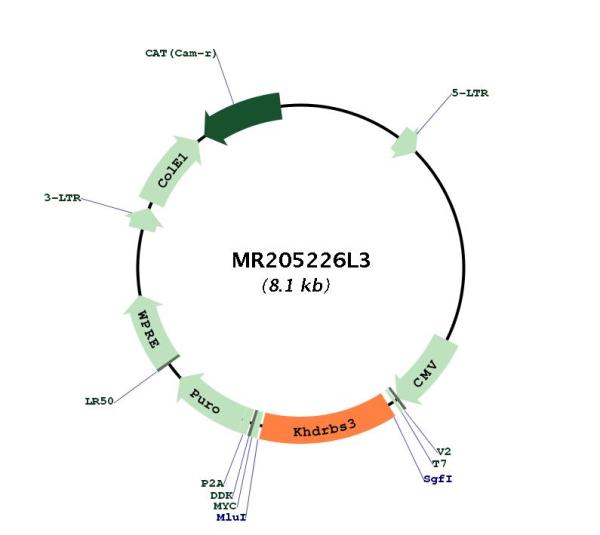Khdrbs3 (NM_010158) Mouse Tagged Lenti ORF Clone
CAT#: MR205226L3
- LentiORF®
Lenti ORF clone of Khdrbs3 (Myc-DDK-tagged) - Mouse KH domain containing, RNA binding, signal transduction associated 3 (Khdrbs3)
"NM_010158" in other vectors (4)
Interest in protein/lysate? Submit request here!
Specifications
| Product Data | |
| Type | Mouse Tagged ORF Clone |
| Tag | Myc-DDK |
| Symbol | Khdrbs3 |
| Synonyms | Etle; Salp; SLM-2; Slm2; T-STAR |
| Vector | pLenti-C-Myc-DDK-P2A-Puro |
| E. coli Selection | Chloramphenicol (34 ug/mL) |
| Mammalian Cell Selection | Puromycin |
| Sequence Data |
The ORF insert of this clone is exactly the same as(MR205226).
|
| Restriction Sites |
SgfI-MluI
Cloning Scheme for this gene
Plasmid Map

|
| ACCN | NM_010158 |
| ORF Size | 1041 bp |
| OTI Disclaimer | The molecular sequence of this clone aligns with the gene accession number as a point of reference only. However, individual transcript sequences of the same gene can differ through naturally occurring variations (e.g. polymorphisms), each with its own valid existence. This clone is substantially in agreement with the reference, but a complete review of all prevailing variants is recommended prior to use. More info |
| OTI Annotation | This clone was engineered to express the complete ORF with an expression tag. Expression varies depending on the nature of the gene. |
| Product Components | The ORF clone is ion-exchange column purified and shipped in a 2D barcoded Matrix tube containing 10ug of transfection-ready, dried plasmid DNA (reconstitute with 100 ul of water). |
| Reconstitution | 1. Centrifuge at 5,000xg for 5min. 2. Carefully open the tube and add 100ul of sterile water to dissolve the DNA. 3. Close the tube and incubate for 10 minutes at room temperature. 4. Briefly vortex the tube and then do a quick spin (less than 5000xg) to concentrate the liquid at the bottom. 5. Store the suspended plasmid at -20°C. The DNA is stable for at least one year from date of shipping when stored at -20°C. |
| Reference Data | |
| RefSeq | NM_010158.2, NP_034288.2 |
| RefSeq Size | 1954 bp |
| RefSeq ORF | 1041 bp |
| Locus ID | 13992 |
| UniProt ID | Q9R226 |
| Cytogenetics | 15 30.36 cM |
| Gene Summary | RNA-binding protein that plays a role in the regulation of alternative splicing and influences mRNA splice site selection and exon inclusion. Binds preferentially to the 5'-[AU]UAAA-3' motif in vitro (PubMed:19457263). Binds optimally to RNA containing 5'-[AU]UAA-3' as a bipartite motif spaced by more than 15 nucleotides (By similarity). Binds poly(A). RNA-binding abilities are down-regulated by tyrosine kinase PTK6 (PubMed:15471878). Involved in splice site selection of vascular endothelial growth factor (By similarity). In vitro regulates CD44 alternative splicing by direct binding to purine-rich exonic enhancer (By similarity). Can regulate alternative splicing of neurexins NRXN1-3 in the laminin G-like domain 6 containing the evolutionary conserved neurexin alternative spliced segment 4 (AS4) involved in neurexin selective targeting to postsynaptic partners such as neuroligins and LRRTM family members. High concentrations in forebrain structures block splicing inclusion of NRXN1-3 AS4 exons while low concentrations favor their inclusion. Targeted, cell-type specific splicing regulation of NRXN1 at AS4 is involved in neuronal glutamatergic synapse function and plasticity and is linked to behavioral aspects (PubMed:22196734, PubMed:23637638, PubMed:24469635, PubMed:27174676). Regulates expression of KHDRBS2/SLIM-1 in defined neuron populations in the hippocampus by modifying its alternative splicing resulting in a transcript predicted to undergo nonsense-mediated decay (PubMed:25505328). Can bind FABP9 mRNA (PubMed:19916944). May play a role as a negative regulator of cell growth. Inhibits cell proliferation.[UniProtKB/Swiss-Prot Function] |
Documents
| Product Manuals |
| FAQs |
| SDS |
Resources
Other Versions
| SKU | Description | Size | Price |
|---|---|---|---|
| MC207268 | Khdrbs3 (untagged) - Mouse KH domain containing, RNA binding, signal transduction associated 3 (Khdrbs3), (10ug) |
USD 503.00 |
|
| MG205226 | Khdrbs3 (tGFP-tagged) - Mouse KH domain containing, RNA binding, signal transduction associated 3 (Khdrbs3) |
USD 657.00 |
|
| MR205226 | Khdrbs3 (Myc-DDK-tagged) - Mouse KH domain containing, RNA binding, signal transduction associated 3 (Khdrbs3) |
USD 457.00 |
|
| MR205226L4 | Lenti ORF clone of Khdrbs3 (mGFP-tagged) - Mouse KH domain containing, RNA binding, signal transduction associated 3 (Khdrbs3) |
USD 757.00 |
{0} Product Review(s)
Be the first one to submit a review






























































































































































































































































 Germany
Germany
 Japan
Japan
 United Kingdom
United Kingdom
 China
China


